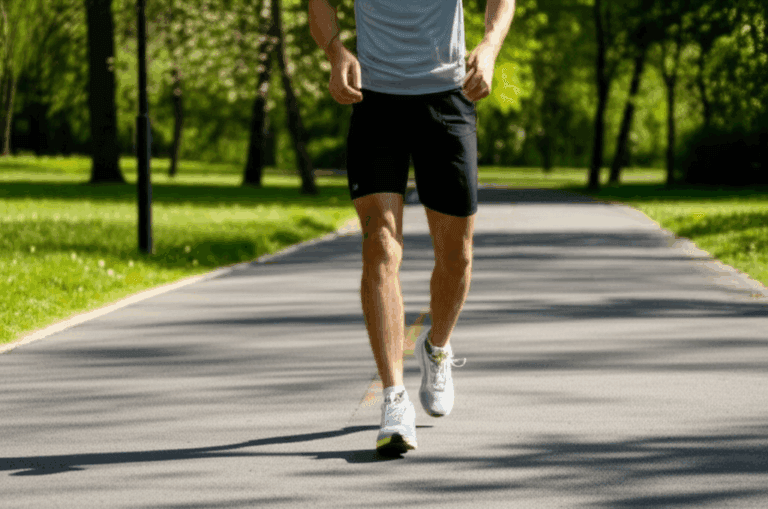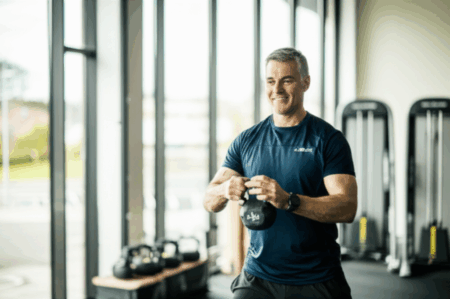Forget endless hours on the treadmill! A simple, science-backed Japanese walking routine is making waves as a potentially superior alternative to traditional gym workouts. This isn’t just a leisurely stroll; it’s a strategic interval-based approach that maximizes health benefits in a minimal amount of time. Let’s dive into the details of this fitness trend and explore why it might be the perfect way to boost your well-being.
What is Japanese Walking?
Japanese walking, also known as Interval Walking Training (IWT), was developed by Professor Hiroshi Nose and Associate Professor Shizue Masuki from Shinshu University in Matsumoto, Japan. It’s a structured walking technique that alternates between periods of fast (brisk) and slow walking. This method is designed to improve cardiovascular fitness, metabolism, and overall health, and is accessible to people of all ages and fitness levels.
The Core Concept
The routine involves alternating between:
- Fast Walking: 3 minutes at roughly 70% of your peak aerobic capacity. You should be able to speak, but continuous talking might be challenging. Aim for a level of exertion that feels like a 7 or 8 out of 10.
- Slow Walking: 3 minutes at about 40% of your peak aerobic capacity, allowing your heart rate to come down.
This 6-minute cycle is repeated for approximately 30 minutes, ideally four times a week.
The Science-Backed Benefits
Recent research, including a clinical trial published in the Journal of Diabetes Investigation (2025), has highlighted the significant benefits of Japanese walking, particularly for individuals with type 2 diabetes and lower-limb weakness.
Key Improvements Observed
- Enhanced Physical Function: The interval walking group showed a statistically significant increase in walking speed.
- Improved Quality of Life: Participants experienced a noticeable improvement in their physical quality of life.
- Cardiometabolic Health: Studies have shown improvements in blood pressure, blood glucose levels, body mass index (BMI), and aerobic capacity.
- Muscle Strength: Interval walking training has been found to improve muscle strength, an important indicator of stability and balance.
Why It Works
The effectiveness of Japanese walking lies in its ability to challenge the cardiovascular system in a dynamic way. By alternating between high and low-intensity intervals, the body is stimulated to adapt and improve its overall fitness level. This method is also considered safer than High-Intensity Interval Training (HIIT) because it dials down the intensity while still providing significant health benefits.
Japanese Walking vs. Traditional Gym Workouts
While both Japanese walking and gym workouts offer health benefits, they cater to different needs and preferences.
Japanese Walking Advantages
- Time-Efficient: The 30-minute routine is easy to fit into a busy schedule.
- Accessibility: Requires no special equipment or gym membership.
- Low-Impact: Gentle on the joints, making it suitable for individuals with joint issues or those recovering from injuries.
- Improved Mobility: Gains in mobility and day-to-day functioning are particularly promising for those with diabetes or age-related muscle decline.
Gym Workout Advantages
- Muscle Development: Gym workouts, especially those involving strength training, are more effective for building muscle mass.
- Holistic Fitness: Gyms offer a wider range of exercises, enabling a more comprehensive approach to fitness.
- Intense Calorie Burn: High-intensity workouts at the gym can lead to a higher calorie burn both during and after exercise.
The Verdict
The choice between Japanese walking and gym workouts depends on individual goals and preferences. If you’re looking for a time-efficient, low-impact way to improve your cardiovascular health, mobility, and overall well-being, Japanese walking might be the perfect fit. On the other hand, if you’re focused on building muscle mass or prefer a wider variety of exercises, a gym workout might be more suitable.
Health Benefits of Walking Beyond Japanese Walking
Regardless of the specific technique, walking, in general, offers a wide array of health benefits.
Physical Health Benefits
- Cardiovascular Health: Walking strengthens the heart, enhances blood circulation, and helps stabilize blood pressure. A brisk 30-minute walk can raise heart rate, boost oxygen supply, and lower the risk of heart disease, stroke, and hypertension.
- Weight Management: Regular walking helps burn calories and maintain a healthy weight. While it might not torch calories as rapidly as more intense workouts, it’s a sustainable and low-impact way to stay active.
- Reduced Risk of Chronic Diseases: Walking can help prevent or manage various conditions, including heart disease, stroke, high blood pressure, cancer, and type 2 diabetes.
- Stronger Bones and Muscles: Walking is a weight-bearing exercise that strengthens bones and improves balance. It also increases muscle strength and endurance.
- Increased Energy Levels: Walking increases oxygen flow through the body and can increase levels of hormones that help elevate energy levels.
- Joint Pain Relief: Walking lubricates and strengthens the muscles that support the joints, alleviating joint pain and stiffness, especially for those with arthritis.
Mental Health Benefits
- Reduced Anxiety and Depression: The rhythmic pace of walking can soothe the mind, reducing stress levels and lessening feelings of anxiety and depression.
- Improved Mood: Physical activity triggers the release of brain chemicals that can make you feel happier and more relaxed.
- Enhanced Cognitive Function: Regular walks can help improve memory, attention span, and problem-solving skills.
- Stress Relief: Walking, especially in nature, can clear your head, ease stress, and improve mood.
- Sense of Accomplishment: Carving out the time to take a walk can provide a sense of achievement, which can boost self-esteem.
Longevity
Studies have shown that regular walking can significantly increase life expectancy.
- Increased Lifespan: Walking for as little as 11 minutes a day can lower the risk of premature death by 25 percent.
- Adding Years to Your Life: Setting a goal to walk 160 minutes per day could increase people’s lifespan by around 5 years. Those who are least active could increase their longevity by as much as 11 years.
How to Get Started with Japanese Walking
Ready to give Japanese walking a try? Here’s a step-by-step guide:
- Warm-up: Begin with 5-10 minutes of gentle stretching and light walking to prepare your muscles.
- Interval Walking: Alternate between 3 minutes of brisk walking (70% of peak aerobic capacity) and 3 minutes of slow walking (40% of peak aerobic capacity).
- Repeat: Continue this cycle for a total of 30 minutes.
- Cool-down: Finish with 5-10 minutes of slow walking and stretching to bring your heart rate back to normal.
- Consistency: Aim for at least four sessions per week to reap the full benefits.
Tips for Success
- Find a Comfortable Pace: Adjust the intensity of the fast and slow walking intervals to suit your fitness level.
- Monitor Your Heart Rate: If you have a fitness tracker, use it to monitor your heart rate and ensure you’re within the target zones.
- Listen to Your Body: If you experience any pain or discomfort, stop and rest.
- Make it Enjoyable: Choose a walking route that you find pleasant and motivating.
- Stay Hydrated: Drink plenty of water before, during, and after your walks.
Walking vs. Other Forms of Exercise
While walking offers numerous benefits, it’s essential to consider how it compares to other forms of exercise.
Walking vs. Running
- Calorie Burn: Running generally burns more calories than walking in the same amount of time.
- Impact: Running is a high-impact exercise, while walking is low-impact. This makes walking a better option for individuals with joint issues.
- Cardiovascular Benefits: Both running and walking improve cardiovascular health, but running may offer slightly more benefits in a shorter amount of time.
- Sustainability: Walking may be more sustainable for some individuals due to its lower intensity and reduced risk of injury.
Walking vs. Gym Workouts
- Muscle Strength: Gym workouts, especially those involving strength training, are more effective for building muscle mass.
- Calorie Burn: High-intensity workouts at the gym can lead to a higher calorie burn both during and after exercise.
- Variety: Gyms offer a wider range of exercises, enabling a more comprehensive approach to fitness.
- Accessibility: Walking is more accessible than gym workouts, as it requires no special equipment or membership.
Maximizing Your Walking Routine for Mental Health
To get the most out of your walking routine for mental well-being, consider these tips:
- Walk in Nature: Studies have shown that walking in nature can decrease depression, improve well-being and mental health, and lower perceived stress.
- Practice Mindfulness: Focus on your surroundings, paying attention to the colors, sounds, and smells around you.
- Set Intentions: Before you start walking, set intentions for your walk, such as reflecting on what you’re grateful for or processing emotions.
- Socialize: Walk with friends or family to boost your mood and reduce feelings of loneliness or isolation.
- Try the 5-4-3-2-1 Grounding Exercise: Engage your senses by noticing five things you can see, four things you can touch, three things you can hear, two things you can smell, and one thing you can taste.
Making Walking a Daily Habit
Consistency is key to reaping the full benefits of walking. Here are some tips for making walking a daily habit:
- Start Small: Begin with 10-15 minutes each day and gradually increase the time as you build stamina.
- Make it Part of Your Routine: Incorporate walking into your daily schedule, such as walking to work, during your lunch break, or after dinner.
- Set Realistic Goals: Set achievable goals for your walking routine and track your progress.
- Find a Walking Buddy: Walking with a friend can help you stay motivated and accountable.
- Reward Yourself: Celebrate your progress with healthy rewards, such as a new pair of walking shoes or a relaxing massage.
The Takeaway
The 30-minute Japanese walking routine offers a simple, effective, and science-backed way to improve your physical and mental well-being. Whether you’re looking to boost your cardiovascular health, manage your weight, reduce stress, or simply add more movement to your day, this interval-based approach can be a game-changer. So, step aside, gym – the Japanese walking revolution is here!







